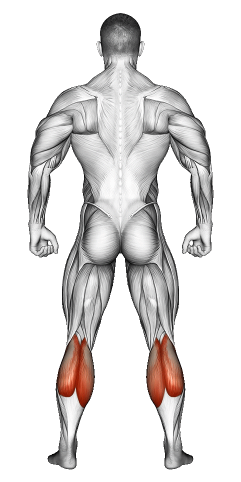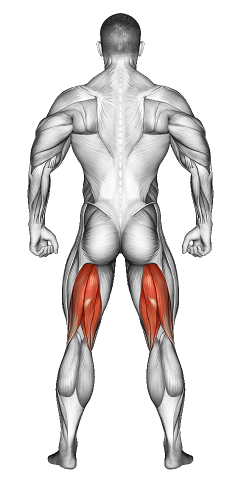Standing Calf Stretch: Video Tutorial & Stretch Guide

Written By: Claude Michael
Updated: Dec 18, 2024
| Workout | Standing Calf Stretch |
| Primary Muscle Group | Calves |
| Secondary Muscle Group | Hamstrings |
| Equipment Required | Wall or sturdy surface for support |
| Force Type | Static Stretch |
| Mechanics | Isolation |
| Exercise Type | Flexibility and Mobility |
| Difficulty | Beginner |
Standing Calf Stretch: Video Tutorial & Stretch Guide
- 1.Standing Calf Stretch: Muscle Groups
- -1.1Primary Muscle Group
- -1.2Secondary Muscle Group
- 2.Standing Calf Stretch: Step-by-Step Guide
- 3.Standing Calf Stretch: Overview
- 4.Standing Calf Stretch: Benefits
- 5.Standing Calf Stretch: Pro Tips & Advanced Techniques
- 6.Standing Calf Stretch: Progression Plan
- 7.Standing Calf Stretch: Frequently Asked Questions (FAQs)
Secondary Muscles Group
Standing Calf Stretch: Step-by-Step Guide
- Step 1: Stand facing a wall or a sturdy surface. Place your hands against the wall at shoulder height for support. Step your right foot back about 2-3 feet, keeping it flat on the ground. Your left foot stays forward with the knee slightly bent.
- Step 2: Press your right heel into the ground and lean forward slightly into the wall. Keep your back leg straight as you feel the stretch along your right calf and down toward your heel. Avoid lifting your heel off the floor.
- Step 3: Hold this position for 15-30 seconds. Breathe deeply, and with each exhale, try to press your heel down a bit more to deepen the stretch.
- Step 4: Return to the starting position by stepping your right foot back up to meet your left foot. Switch sides by stepping your left foot back and repeating the stretch.e
- Step 5: Repeat the stretch on each side 2-3 times. With each round, try to reach a bit deeper into the stretch to increase your flexibility and release tension in your calves.
Standing Calf Stretch: Overview
The Standing Calf Stretch increases flexibility in your calves and helps release tension in the Achilles tendon. By regularly practicing this stretch, you improve lower leg mobility and reduce the risk of calf strain or injury. It’s a simple stretch that supports everyday activities like walking, running, and jumping.
Standing Calf Stretch: Benefits
The Standing Calf Stretch keeps your calves and Achilles tendon flexible and reduces tightness from standing or intense leg workouts. By stretching your calves regularly, you improve ankle mobility, prevent injury, and enhance your lower body movement. This stretch is perfect for any warm-up or cooldown routine.
Standing Calf Stretch: Pro Tips & Advanced Techniques
- Focus on Heel Placement: Keep your back heel flat on the ground throughout the stretch. This ensures you fully engage your calf muscles.
- Use Deep Breaths: Breathe deeply, using each exhale to relax into the stretch a bit more. This helps you stretch deeper without forcing it.
- Avoid Leaning Forward Too Much: Keep a slight forward lean without bending excessively. Your goal is to feel a gentle stretch in your calf, not strain.
- Increase Depth Gradually: Over time, try stepping further back or leaning slightly deeper to improve your calf flexibility.
Standing Calf Stretch: Progression Plan
Beginner
Intermediate
Advanced
Standing Calf Stretch: Frequently Asked Questions (FAQs)
What muscles does the Standing Calf Stretch work?
+It stretches the calves and Achilles tendon, helping release tension and increase flexibility in your lower leg.
Can I add the Standing Calf Stretch to any workout?
+Yes! This stretch fits well into any lower body warm-up or cooldown routine. Use it to relax tight calves after a workout.
Does the Standing Calf Stretch improve ankle mobility?
+Absolutely. Stretching your calves regularly supports ankle flexibility, which is key for better balance and movement.
How often should I do the Standing Calf Stretch?
+Include it in your routine 3-4 times a week, especially after standing for long periods or doing leg-intensive exercises.
What mistakes should I avoid?
+Don’t lift your heel off the ground or force the stretch too far. Focus on keeping your heel down, using smooth, controlled movements and deep breaths for a safe and effective stretch.
Share
Don’t Wish for It, Work for It – Join the FlexXP Newsletter Today!
Thank you for signing up for the FlexXP Newsletter!
This site is protected and the Google Privacy Policy and Terms of Service apply.

